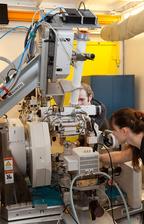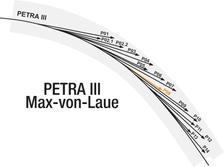The location of P08 in the Max-von-Laue Experimental Hall is marked in orange.
NEW: mail-in experiments available. Check here for more details.
At beamline P08 high resolution diffraction and scattering studies on solid or liquid samples can be conducted. For this the X-ray beam can be tuned to very small diameters and high energy resolution without introducing large divergence or suffering from higher harmonic contermination. Accurate diffractometers, modern 2d-detectors and sample environment are available.
Beamline P08 resides at the 3rd generation synchrotron radiation source PETRA III in Hamburg, Germany. P08 is online since fall 2009 and designed for high resolution diffraction and scattering studies of condensed matter samples. High resolution in this context alludes to real space and simultaneously reciprocal space. In other words, in diffraction geometry crystal lattice parameters can be determined with an accuracy of 10-5 whereas small angle scattering and in some cases reflectometry is sensitive to length scales up to some micrometers, which corresponds to some 10‑4Å‑1. Larger objects can be investigated by tuning the beam spot down to 20x2 µm2 (horizontally x vertically) and rasterizing the sample.
P08 is an undulator beamline, and the beam properties can be adjusted in a wide range by the use of the high heat-load double crystal monochromator (DCM), the large offset monochromator (LOM) and two sets of compound refractive lenses (CRL), one at the optics hutch with 30 m focal length and one in the experimental hutch with 1.5 m focal length. The use of the CRLs determines the four modes at which P08 can run: the raw mode (RM) with unfocused beam, the collimation mode (CM), the focusing mode (FM) using the lenses in the optics hutch only, and the micro-focusing mode (µM). The photon energy can be tuned between 5.4 and 29.4 keV with a flux of 1011 to 1012 photons per second, a beam size between 1500x100 µm2 and 20x2 µm2 at an energy resolution of some 10-5. X-ray mirrors are not in use. The suppression of the higher harmonic radiation is realized by the monochromator crystals with an efficiency of 108.
In the experimental hutch 3 experimental stations are available. A high precision 6-circle diffractometer with Eulerial cradle serves for investigations at hard condensed matter samples. It can fit sample environments of 15kg weight with precision of 0.0005° and wobble of 20µm. It is mainly used for structural investigations and strain/stress determination. Other applications are powder diffraction at complex materials, reflectometry and small angle scattering. Available for the experiments are an HV oven for 400°C, a rough vacuum oven for temperatures up to 1100°C and a cooling stage for the temperature range from -180°C up to 500°C. Other setups can been adapted on request, for example, a timing setup with resolution of 0.1 ns. For liquid samples the specialized diffractometer LISA, which has been constructed by University of Kiel, is available. It can handle apparatus for liquids, such as Langmuir troughs and has also been used for heavy load setups such as an in-situ sputtering chamber for investigations magneto-electric interfaces. Furthermore, an additional setup dedicated to diffraction measurements from Langmuir monolayers at the vapour/liquid interface under fixed incident is available. Area detectors are available for the experiments: a Dectris Pilatus-100k pixel detector, a large area Perkin Elmer flat-panel detector, a Dectris Eiger-1M pixel detector from University of Kiel, a XSpectrum Lambda 750k GaAs from University of Kiel.







